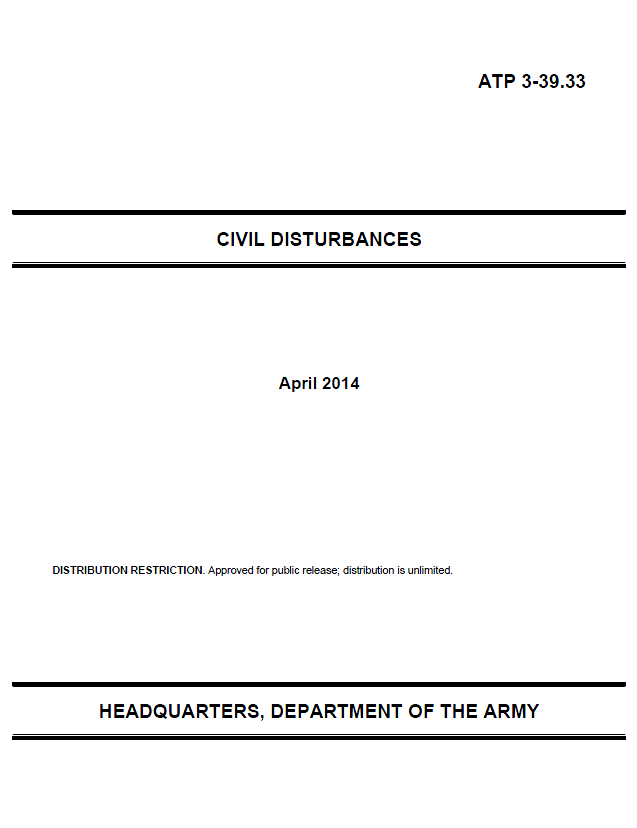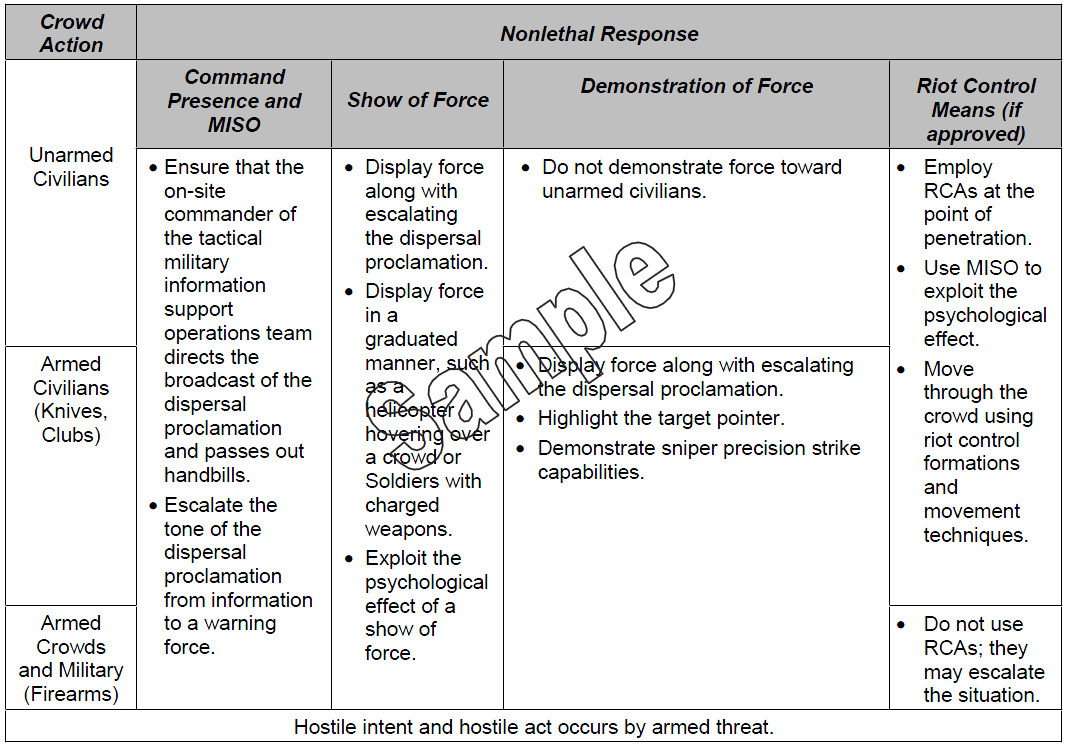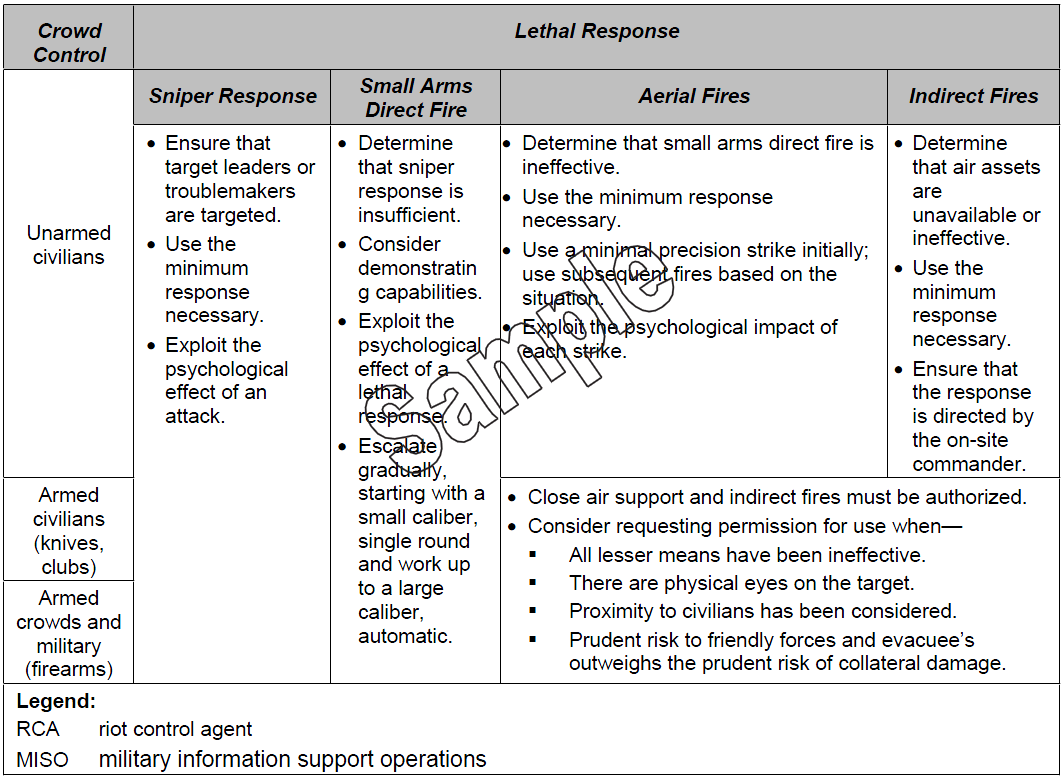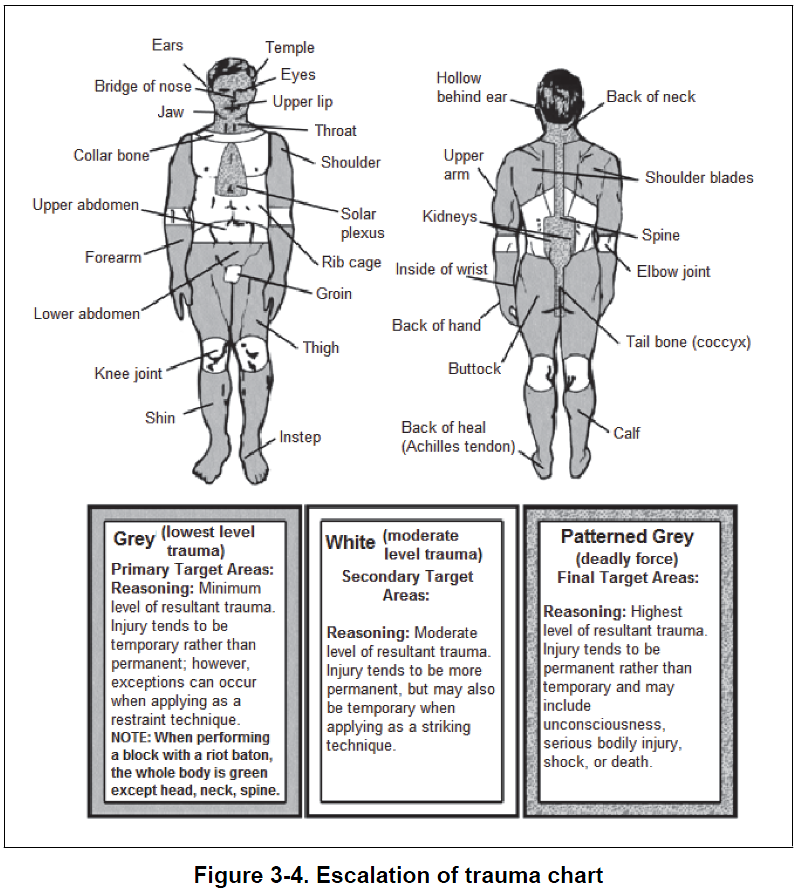ATP 3-39.33 CIVIL DISTURBANCES
- 132 pages
- April 2014
- 4.9 MB
ATP 3-39.33 provides discussion and techniques about civil disturbances and crowd control operations that occur in the continental United States (CONUS) and outside the continental United States (OCONUS). United States (U.S.) forces deploy in support of unified action, overseas contingency operations, and humanitarian assistance worldwide. During these operations, U.S. forces are often faced with unruly and violent crowds who have the intent of disrupting peace and the ability of U.S. forces to maintain peace. Worldwide instability coupled with U.S. military participation in unified-action, peacekeeping, and related operations require that U.S. forces have access to the most current doctrine and techniques that are necessary to quell riots and restore public order.
…
CIVIL UNREST
1-1. Demonstrations, public disorder, and riots happen for a number of reasons. Some of these reasons are economic hardships, social injustices, ethnic differences (leading to oppression), objections to world organizations or certain governments, political grievances, terrorist acts, other man-made disasters, and natural disasters. Civil unrest is when a civil society or a segment of its population is in a disturbed or uneasy state or in turmoil. During a state of civil unrest, an event can be triggered by a single cause or a combination of causes. For example, operations that occurred in the Balkans that involved civil unrest were the result of ethnic hatred, a lack of civil authority, food shortages, a revolution, and religious-based fighting factions.
1-2. Civil unrest may range from simple, nonviolent protests that address specific issues, to events that turn into full-scale riots. Gathering in protest may be a recognized right of any person or group, regardless of where U.S. forces may be operating. In the United States, this fundamental right is protected under the Constitution of the United States, while other countries have various laws that protect the rights of their citizens rights. During unified action, U.S. forces should never violate basic civil or human rights. Most protesters are law-abiding citizens who intend to keep their protests nonviolent, but some protest planners insist that the event involve violence. Often in the media, protesters can gain sympathy for their cause by prompting authorities to take physical action against them. Violence can be the result of demonstrators beginning to conduct unlawful or criminal acts and authorities (who are responsible for the safety and welfare of all) enforcing the laws of the municipality, state, or nation. The level of violence is determined by the willingness of demonstrators to display and voice their opinions in support of their cause and the actions and reactions of the control force on scene.
1-3. Commanders must be aware of the possibility that some individuals or groups within an organized demonstration may intend to cause disruption, incite violence, destroy property, and provoke authorities. The situation and actions of the crowd may dictate control and enforcement options. Agitators and criminal infiltrators within the crowd can lead to the eruption of violence. Inciting a crowd to violence or a greater intensity of violence by using severe enforcement tactics must be avoided.
1-4. Community unrest results in urban conflicts that arise from highly emotional social and economic issues. Economically deprived residents may feel that they are treated unjustly or ignored by people in power and authority. Tensions can build quickly in a community over a variety of issues, such as hunger, poor employment opportunities, inadequate community services, poor housing, and labor issues. Tensions in these areas create the potential for violence. When tensions are high, it takes a small (seemingly minor) incident, rumor, or perceived act of injustice to ignite groups within a crowd to riot and act violently. This is particularly true if community relations with authorities are strained.
1-5. Significant ethnic differences in a community can create an atmosphere of distrust, even hatred. Unrest among ethnic groups competing for jobs, living areas, and sparse essentials can cause an eruption of civil disorder that can lead to full riots. As emotions run high, violence becomes likely.
1-6. Terrorist organizations may infiltrate groups within a demonstrating crowd. These terrorist groups may intend to embarrass their government or other governments. Terrorist infiltrators can be used to provoke crowds as a diversion, as part of a demonstration, or as cover for terrorist acts.
…
THREAT ANALYSIS AND CROWD ASSESSMENT
2-18. Threat analysis is vital for any military mission. The assessment of crowds requires its own set of questions. These questions should be answered before a crowd assembles or as quickly as possible. In some cases, all the questions may not be answered. The following questions represent a logical way to develop an understanding of the crowd the commander is tasked to control.
Who are they and what is the overarching identity of the crowd? Do they identify themselves as strikers, ethnic groups, religious factions, social protestors, some other group, or even a combination of these? Understanding who they are will indicate what they may do. It may be possible to determine identities and goals from advance assembling instructions, leaflets distributed to bystanders, placards and banners, or chants and songs.
What are their goals? What the group wants to accomplish by assembling could determine the extent to which they can be accommodated once they have assembled. They may only seek recognition for their cause (being seen and heard). If so, this goal is usually easy to accommodate. However, some groups may have more demanding goals, for example the demonstrators in Seattle who sought to stop the World Trade Organization. Goals that cannot be accommodated make confrontation very likely.
What is the composition of the crowd and are there any known factions? Seattle demonstrations against the World Trade Organization were composed of groups that were protesting environmental issues, wages, and child labor laws. Differing goals and the resulting friction were evident between such organizations as the Ruckus Society and the American Federation of Labor-Congress of Industrial Organizations. Factions within a crowd represent threats and opportunities.
What are they capable of doing? Protest groups often claim that they will assemble large numbers of people to produce some disruptive action. However, there is often a difference between the claim and reality. An organization may claim that it can mass a 100,000 people, but in reality can only get 40,000. Organizers exaggerate because they want to boost the morale of their own people and they want the media to report that they have strength in numbers. Studying the past activities of a group may provide indications of what they are capable of doing in the future.
What are their traditional behaviors or cultural repertoires? What people do during protests is not universal. It varies with the group, individual, and the culture. Social protestors and striking unions may carry placards and banners, while other groups may protest in a quiet way. Understanding these behaviors, along with their goals, can be helpful in deciding how to respond.
When and where will they assemble? Every protest organizer has a time and place for assembling and a destination for the crowd to move toward. If the organizer attempts to mobilize large numbers of participants, the time and place for assembling and dispersing must be made known in the instructions. This information may be stated in the mobilization instructions or disseminated by an informal network, such as word of mouth. Such impromptu networks in densely populated areas can enable rapid assembling. Knowing the location is a key to planning for a commander and their staff.
Where will they go? Many crowds have destinations. Organizations may march a specified distance to ensure that their cause gets sufficient attention. Commanders need to know the route to minimize disruptions to the rest of the community. Knowing the route allows LEAs to take such measures as rerouting traffic to prevent congestion caused by protest marches. It is also necessary to provide security along the route to prevent counterdemonstrators from confronting the marchers. This will prevent an even greater problem for the community.
What are the possible targets of violence? Riot participants, in particular, may focus on target facilities, personnel, or objects. There is no set target list for rioters, and it depends on the location and what is in the area. Some common targets include: authority figures (the control force), government facilities, food supply facilities, gun stores, retail stores (especially those with high value items), and symbols of authority or government (such as statues, flags, or signs).
When and where will they disperse? Crowds have a life cycle that includes how they disperse (see chapter 1). Commanders must consider this. It is essential that there be one or more avenues that individuals and groups can use to disperse. These dispersal routes should be clearly marked, visible, and open-ended. There may be a need for U.S. forces to assist the crowd with dispersal. Assistance includes: securing routes, marking routes, and providing or helping arrange transportation.
Are there plans for subsequent gatherings? Organizers may have multiple gatherings planned on different dates or locations. Also, a crowd may disperse for a short time so that participants can take care of personal needs. This could be days or only a few hours.
What is the worst-case scenario? Worst-case scenarios must be recognized, discussed, and planned for, if for nothing else, to avoid them. This could be when an originally peaceful demonstration evolves into a full-blown riot.
…
LEGAL CONSIDERATIONS
2-3. Commanders must know the legal boundaries, their sources, and how they apply to interacting with civilians in OCONUS and CONUS. The staff judge advocate (SJA) office is able to assist with information as well. The SJA office should be included in planning and involved in any activity with potential legal implications. For civil disturbance missions there are differences in the legal boundaries, and in how U.S. federal forces can be utilized, depending on if the event is within the United States or within a foreign country. The planning and execution for these missions needs to be conducted within those legal parameters.
Continental United States Versus Outside the Continental United States
2-4. For the U.S. Army, conducting civil disturbance missions within the United States. will vary greatly when compared to conducting civil disturbance missions within a foreign country where the U.S. Army is conducting operations. Except as expressly authorized by the Constitution of the United States or by another act of Congress, the Posse Comitatus Act (18 USC 1385) prohibits the use of the Active Army as enforcement officials to execute state or federal law and perform direct law enforcement functions within CONUS. For OCONUS operations, especially when the HN does not have a legitimate government or law
enforcement capabilities, the U.S. Army may have to perform these functions, including responding to civil
disturbances and performing the tactics and techniques discussed in this manual.2-5. When the U.S. Army is conducting unified land operations within a foreign country, and there is a need for U.S. forces to conduct a civil disturbance mission, there are certain legal considerations that must be made. These considerations include (if applicable): United Nations or non-United Nations mandates, status-of-forces agreements, international laws, HN laws, the civil authorities (if functioning) of the foreign country, and ROE.
2-6. Within CONUS, military operations would fall under the defense support of civil authorities (see ADP 3-28 and ADRP 3-28). Military support to law enforcement is one of two categories: direct and indirect support. When authorized by the Secretary of Defense, federal military forces may provide indirect support to law enforcement agencies; but support is limited to logistical, transportation, and training assistance except when emergency authority applies. State and territorial governors can use state National Guard forces for direct support to civilian law enforcement; however, such use is a temporary expedient and must be in accordance with state laws (see ADP 3-28).
2-7. The Constitution of the United States, laws, regulations, policies, and other legal issues limit the use of federal military personnel in domestic support operations. Any Army involvement in civil disturbance operations involves many legal issues requiring comprehensive legal reviews. However, federal forces are authorized for use in civil disturbance operations under certain circumstances. The following references pertain to the use of federal forces within the United States, therefore; commanders, staffs, and leaders must be familiar with, and adhere to, the parameters within them—
Insurrection Act (10 USC 333–334).
- Posse Comitatus Act (18 USC 1385).
- 32 CFR, Part 215.
- AR 381-10.
- DODD 3025.18.
- DODI 3025.21.
- NGR 500-1.
2-8. The Constitution of the United States provides two exceptions for which the Posse Comitatus Act does not apply. These exceptions are based upon the inherent right of the U.S. government to ensure the preservation of public order and to carrying out governmental operations within its territorial limits by force, if necessary. These two exceptions are—
- Emergency authority. A sudden and unexpected civil disturbance, disaster, or calamity may seriously endanger life and property and disrupt normal governmental functions to such an extent that local authorities cannot control the situation. At such times, the federal government may use military force to prevent the loss of life or wanton destruction of property and to restore government functions and public order. In these circumstances, federal military commanders have the authority, in extraordinary emergency circumstances where prior authorization by the President is impossible and duly constituted local authorities are unable to control the situation, to engage temporarily in activities that are necessary to quell large-scale, unexpected civil disturbances (see DODD 3025.18).
- Protection of federal property and functions. When the need for the protection of federal property or federal functions exists, and duly constituted local authorities are unable to, or decline to provide adequate protection, federal action, including the use of military forces, is authorized.
2-9. Laws passed by the U.S. congress include four exceptions to the Posse Comitatus Act. With the first
three laws discussed below (10 USC 331–333) there is a prerequisite that the President must take personal action, including the issuance of a proclamation calling upon insurgents to disperse and retire peaceably
within a limited time. The four exceptions, based on law are—
- 10 USC 331. When a state is unable to control domestic violence and they have requested federal assistance, the use of the militia or Armed Forces is authorized.
- 10 USC 332. When ordinary enforcement means are unworkable due to unlawful obstructions or rebellion against the authority of the United States, use of the militia or Armed Forces is authorized.
- 10 USC 333. When a state cannot or will not protect the constitutional rights of the citizens, due to domestic violence or conspiracy to hinder execution of State or Federal law, the use of the militia or Armed Forces is authorized.
- House Joint Resolution 1292. This resolution directs all departments of the U.S. government, upon request of the Secret Service, to assist in carrying out its statutory duties to protect government officials and major political candidates from physical harm.




